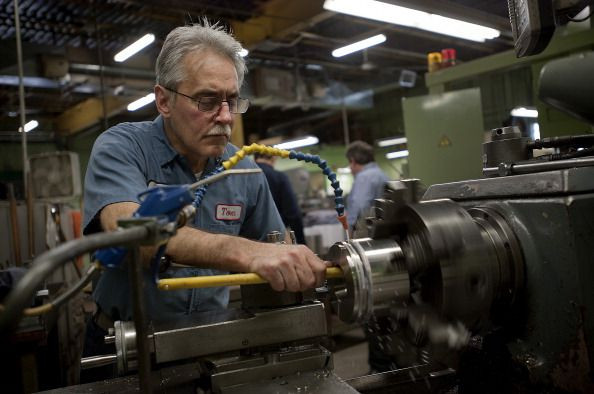US Manufacturing Declines At A Slower Pace

U.S. manufacturing activity contracted in January for a fourth straight month as factories grappled with a strong dollar and lower oil prices forced energy firms to further cut spending, but the pace of the decline appeared to be slowing.
While other data on Monday showed consumer spending was flat in December, a jump in savings to a three-year high offered hope that consumption would rebound in the coming months.
"The bad news is manufacturing is still contracting, but the good news is there are some signs of stabilization. There are still some dark clouds hovering over the first quarter and we hope consumers will return as savings are high," said Thomas Costerg, an economist at Standard Chartered Bank in New York.
The Institute for Supply Management (ISM) said its index of national factory activity increased 0.2 percentage point to a reading of 48.2 last month. A reading below 50 signals a contraction in factory activity.
The buoyant dollar has combined with tepid global demand to undermine U.S. exports. At the same time, businesses are working to reduce a huge pile of unsold merchandise clogging warehouses, which has left little scope to place new orders with factories.
But there are rays of hope for the sector, which accounts for 12 percent of the economy. Last month, more factories reported an increase in orders and production. In addition, inventory levels and order books appeared to be stabilizing.
However, manufacturing employment continued to decline and export orders weakened from the prior month. Factories with close links to the slumping oil and gas sector reported ongoing challenges. The survey showed some suppliers reported that "filing for bankruptcy and reducing their workforce is becoming an increasing risk."
The signs of stabilization in manufacturing were also captured in a separate report from data firm Markit, which showed its U.S. manufacturing PMI rebounded last month from December's 38-month low. That survey also reported faster growth in production and new orders.
"The contraction in manufacturing is ongoing but no longer getting worse," said Steve Blitz, chief economist at ITG Investment Research in New York. "If, in fact, the recent stability in new orders follows with some improvement, inventory has been worked off enough for increased new orders to generate improved growth rates for production."
In a third report, the Commerce Department said consumer spending was unchanged in December after increasing 0.5 percent in November. Spending on long-lasting manufactured goods such as autos dropped 0.9 percent. Purchases of nondurable goods, including apparel, also fell 0.9 percent.
Consumer spending, which accounts for more than two-thirds of U.S. economic activity, increased 3.4 percent in 2015 after advancing 4.2 percent in 2014.
U.S. stocks were trading lower as weak Chinese data renewed fears about a global slowdown and oil prices resumed their slide. The dollar weakened against a basket of currencies. Prices for U.S. government debt also were lower.
LOW INFLATION
Amid weak consumption, inflation retreated in December, with a price index for consumer spending slipping 0.1 percent after ticking up 0.1 percent in November.
In the 12 months through December, the personal consumption expenditures (PCE) price index, however, rose 0.6 percent - the largest increase since December 2014. Year-over-year inflation rates are rising as the weak readings during the year drop out of the calculation.
Excluding food and energy, prices were unchanged after rising 0.2 percent in November. The so-called core PCE price index, the Federal Reserve's preferred inflation measure, increased 1.4 percent in the 12 months through December. Core PCE is below the U.S. central bank's 2 percent target.
"The lack of inflationary pressure in the PCE deflator measures of prices is another reason why the Fed could stand pat in March," said Paul Ashworth, chief U.S. economist at Capital Economics in Toronto, referring to the Fed's next interest rate-setting policy meeting.
The consumer spending data was included in last Friday's fourth-quarter gross domestic product report, which showed consumer spending growth slowed to a 2.2 percent annual rate from the third quarter's brisk 3 percent pace.
Moderate consumer spending, weak export growth and the ongoing efforts to reduce the inventory bloat helped restrict economic growth to a 0.7 percent pace in the fourth quarter.
However, that growth estimate could be lowered to about a 0.5 percent rate after another report from the Commerce Department showed construction spending rose only 0.1 percent in December. That is less than the government had assumed in its advance fourth-quarter GDP growth estimate.
Stoking hopes of a rebound in consumer spending, income rose 0.3 percent in December after a similar gain in November. Income at the disposal of households after accounting for inflation in 2015 recorded its biggest increase since 2006.
With income outpacing spending in December, savings surged to $753.3 billion, the highest level since December 2012, from $717.8 billion in November.
(Reporting by Lucia Mutikani; Additional reporting by Dan Burns in New York; Editing by Paul Simao)
© Copyright Thomson Reuters 2024. All rights reserved.




















